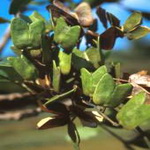| Common Name: |
Umnungwana |
| Other Names: |
Small Knobwood, Kleinperdepram |
| Botanical Name: |
Zanthoxylum capense syn Fagara capensis |
| Genus: |
Zanthoxylum |
| Family: |
Rutaceae |
| Native Location: |
Easter and northern S Africa. |
| Cultivation: |
Fertile soil in sun or shade. Remove dead wood (which is prone to coral spot fungus) and cut back in late winter or early spring. |
| Propagation: |
By seed sown in autumn; by root cuttings in late winter. |
| Harvest: |
Leaves (Z. piperitum) are picked during the growing season and used fresh. Bark is stripped in spring and dried for use in decoctions, liquid extracts, and tinctures. Fruits are collected in summer and dried for use in decoctions and liquid extracts. |
| Height: |
5-10m (15-30ft) |
| Width: |
5-10m (15-30ft) |
| Hardiness: |
Z9-10 |
| Parts Used: |
Bark, Leaves, Fruits |
| Properties: |
A warming, aromatic, antiseptic herb that reduces inflammation, lowers fever, relieves indigestion, and has painkilling effects. |
| Medicinal Uses: |
Internally for stomach upsets, diarrhea, flatulence, colic, cramps, intestinal parasites, tuberculosis, bronchitis, paralysis, epilepsy, and snakebite. Externally for minor injuries, infected sores, insect bites, muscular aches and pains, lumbago, sciatica, toothache, and as a mouthwash for oral hygiene and dental or gum and mouth inflammations. Also used to treat anthrax in cattle, and to make anthrax-infected meat safe for consumption. |
| Economic Uses: |
Leaves added to potpourris. |
| Bibliography: |
The Encyclopedia or Herbs by Deni Bown Copyright © 1995, 2001 Dorling Kindersley Limited. pg. 409 |

